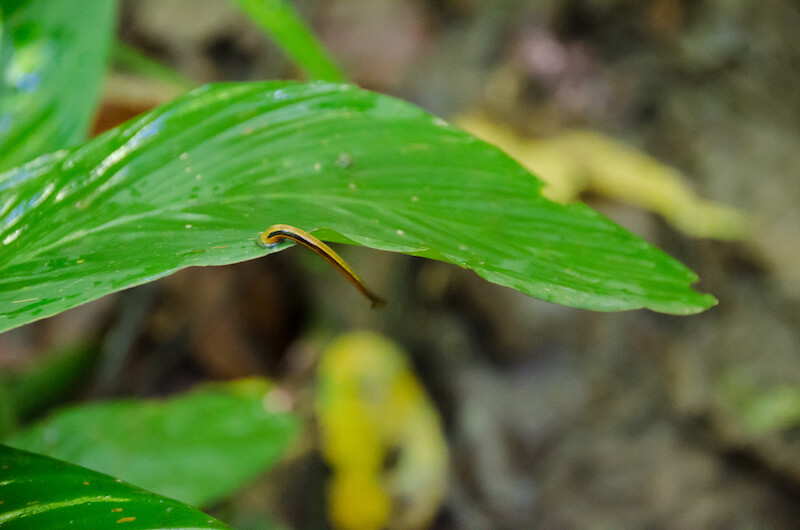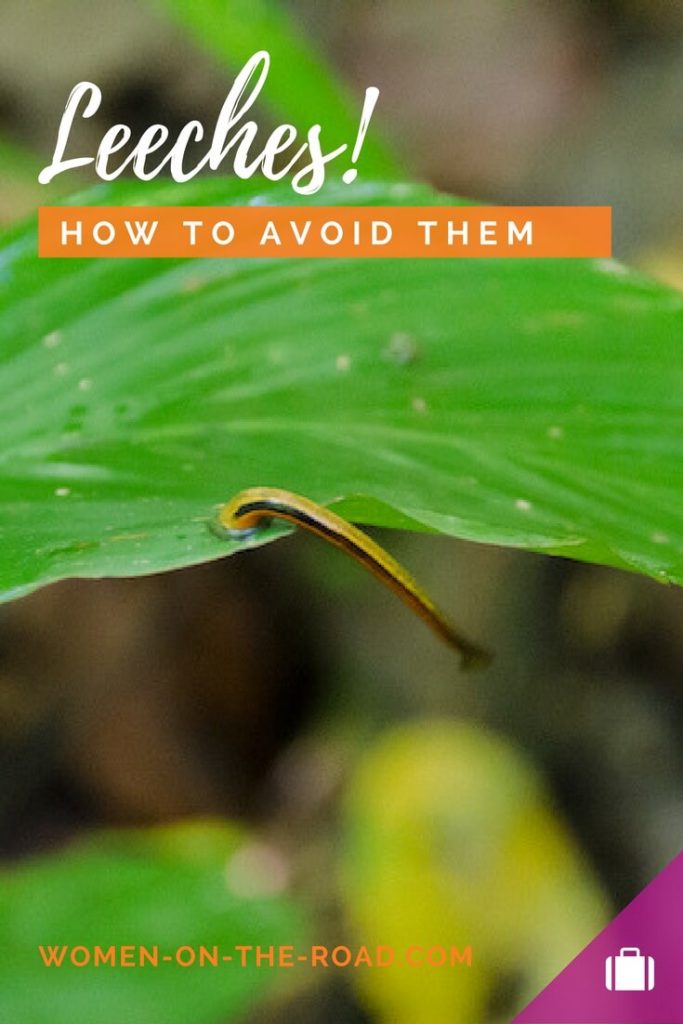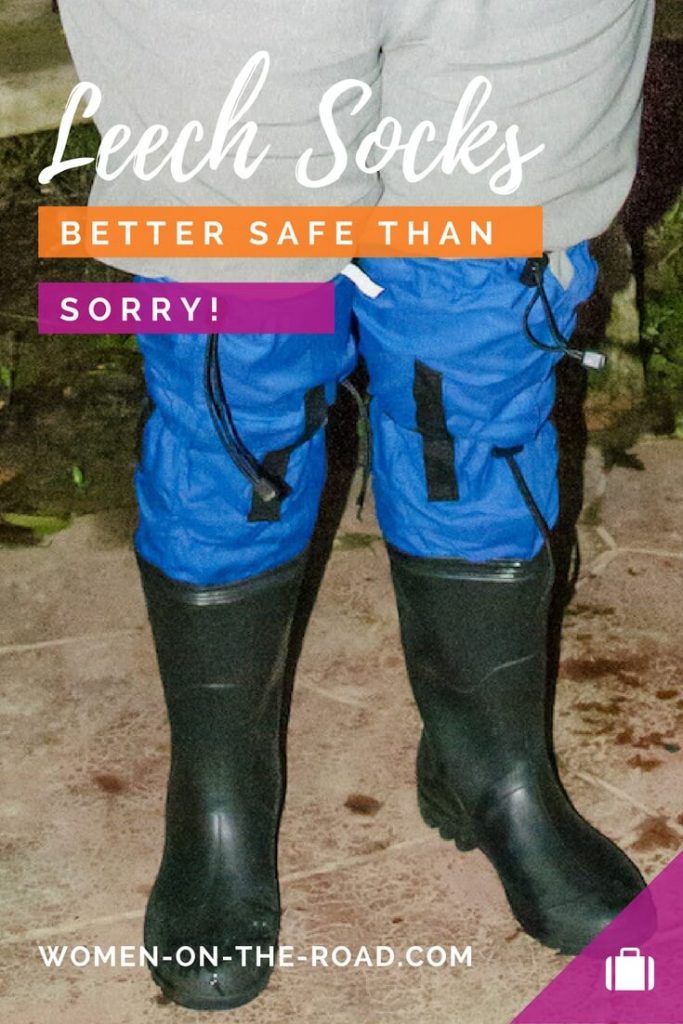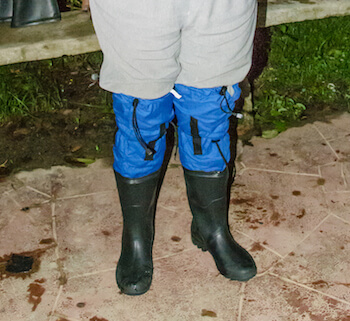Yes, there is such a thing and yes, it could happen during your travels: if you’re headed to a rainforest or to a hot and moist natural destination, do NOT leave your leech socks at home. Period.
Tropical rainforests are wonderful environments. But, the wetter the weather, the hungrier leeches get for your flesh, a fact most tourism boards and travel agencies will underplay. When I was traveling in Borneo, leech protection was an important part of everyday life. (If you’re thinking eeewwww and you’ve already read enough, just head to Amazon and buy a pair of anti-leech socks.)
Otherwise, please keep reading to find out the following: what are leeches, how do you avoid them and how do you remove leeches if they should fall upon you). You won’t only find leeches in rainforests, you’ll also find them in other warm and wet places – lakes, marshes, ponds and the like.
At first sight, they look harmless. I mean – look at this little tiger leech: not attractive, certainly, but not deadly either.

So why worry? Are leeches dangerous? Not in themselves, nor do leeches carry diseases.
While they may not carry disease, by biting you they create an open wound by slashing into your skin. If you’re in the tropics, any open sore or broken skin is much harder to keep clean and more prone to infection. So you should do whatever you can to avoid them.
The only time you might actively want to meet a leech is if you indulge in leech therapy, an ancient art and science which is enjoying a resurgence in health circles. But that’s a different story.
How to avoid leeches and protect yourself with leech proof socks
There are many ways of doing this and buying anti-leech socks is the most obvious and easiest.
But you can do more.
- Wear lighter colors so you can spot them more easily. If they do fall on you, you can immediately brush them away before they attach themselves to you if they find a gap through your clothes.
- Assume that any stagnant water has leeches so don’t let the water come into contact with your skin. The best leech socks will prevent them from coming into contact with your skin.
- Tuck all your clothes in: roll down your sleeves, tighten your cuffs and do up your collar area. Leeches can wriggle into the tiniest gaps and are quite small – until they’ve feasted on you, that is. Leeches love delicate skin, like armpits and genitals, so tuck in your trouser bottoms as well.
- Use anti-leech spray to maximize the effectiveness of your leech protection socks. Spray them with Sawyer’s permethrin for clothes and don’t forget to spray your clothes and boots while you’re at it. This should kill the leech before it starts feasting on you.
- Apply anti-leech protection directly to your body. In addition, if you’re seriously concerned you can also apply DEET to your body, or Picaridin, which is considered less toxic (even though DEET’s toxicity to humans hasn’t been scientifically proven). While it doesn’t deal with leeches specifically, this CDC page tells you all about the different chemical repellents.
Can leeches bite through clothes?
If you’re spraying your own clothes with any kind of mosquito or leech repellent, remember that leeches can push looser weaves apart to get to their meal.
And if you happen to put your backpack or jacket or anything on the ground in this kind of environment, check every corner for leeches before you put it back on!
So if you’re wondering, can leeches bite through leggings? The answer is, sometimes. If you happen to be wearing particularly thin or loose weave clothing, they may be able to get through to your skin.
How to remove a leech if one takes a liking to you
This is really the worst-case scenario but you should at least know how to do it. When I visited the Lower Kinabatangan in Borneo, forest leeches were a constant concern. I wore what I call my “Borneo clothing” – a hat, socks, every possible kind of insect-repellent clothing – the works!
But if you forget your anti-leech pants at home and one gets a hold of you, you’ll need to know how to handle it. So here’s how to get a leech off (bearing in mind I’m not a doctor and that this is common advice you’ll find anywhere):
- Don’t panic. If the leech has been feeding on you, there will be some blood around. The leech feeds on you by pumping a kind of blood anticoagulant into your bloodstream. While that numbs the pain, it also makes you bleed quite a bit even after the leech is removed. Because of the painkiller, a leech could be feasting on you for quite some time before you notice. The wound can bleed for quite a while but it will stop. Don’t worry – you will not bleed to death.
- Work as a team. Since you’ll rarely be heading into the rainforest alone, a good strategy is to pick a “leech buddy”. Choose someone to watch your leeches for you – and you watch theirs. This way, at first alert, you’ll be able to brush it off.
- Encourage the leech to detach. There’s plenty of common wisdom about removing a leech: a lighter flame (ouch, this might hurt you as well as the leech), salt, alcohol, tobacco, your trusty mosquito spray and even spit. The problem with these methods is that the leech might throw up – into the wound, which could mean infection. Still, in my book “encouraging” the leech to detach is much better than the alternative (see below).
- Force the leech to detach. Some people (braver than I) will try to get rid of leeches by hand: gently slide sideways under the leech’s teeth by pushing a fingernail or other hard object under the leech’s sucker. If you succeed, quickly flick the beast off before it bites you again – because it will! But… no thanks, not for me.
- After care of a leech bite. Once the leech is off, use clean paper towels to wipe the area and then disinfect it and spray with hydrogen peroxide, which will help stop the bleeding. Tea tree oil works well too (it’s all I had with me in Borneo). Whatever you do, make sure that wound is CLEAN. Bear in mind that after the leech has been removed, you may continue to bleed for quite some time, even up to an hour or more. That’s normal. Watch your clothing and try to keep it out of the way, because –there will likely be lots of blood, enough to make you look like an extra in a zombie movie.
The best leech protection methods
My recommended product is the basic anti-leech sock below (I have several pairs and never travel to the tropics without them). Are you still wondering, what are leech socks? They are socks that are made from a waterproof-like material and cover your legs up to the knee. They will prevent any leech from getting in.
Leech repellent socks are my number one tip for preventing leech bites. Prevention is better than cure when it comes to these blood sucking creatures.
Anti Leech Hiking Socks from Amazon
I had a wonderful time in Borneo, trekking through the rainforest and discovering rare birds and animals.
My one fear was running into leeches – but I was lucky (and excessively careful). Wearing these unbelievably chic leech socks (and a head net you can’t see) gave me tremendous peace of mind. So I can vouch wholeheartedly for these socks. I walked for hours and not a single leech made it into my socks. That night, at least with me, they went hungry…
Leech protections has become one of my go-to travel accessories when I am in rainforest conditions. Because you don’t want to be spending anytime trying to take leeches off your body.
Here’s why I recommend these socks:
- They are made of 35% cotton so you can use permethrin or those DEET solutions that are compatible with the polyester (read the label).
- They are super-effective for the most vulnerable areas – inside your shoes and up your leg.
- (They’re not too fashionable and you’ll be anything but elegant. But I prefer to be leech-free…)
- One size fits all – they’re 22″/56cm high.
If you know someone headed for warm and wet areas, please share this page with them or post it on your social media to ensure they are prepared for a tropical vacation! AND – don’t forget your travel insurance (I recommend SafetyWing).
PIN THESE PICTURES AND SAVE FOR LATER!




